
Dieffenbachia is a genus of tropical flowering plants in the family Araceae. It is native to the New World Tropics from Mexico and the West Indies south to Argentina. Some species are widely cultivated as ornamental plants, especially as houseplants, and have become naturalized on a few tropical islands.

Anthurium, is a genus of about 1000 species of flowering plants, the largest genus of the arum family, Araceae. General common names include anthurium, tailflower, flamingo flower, and laceleaf.
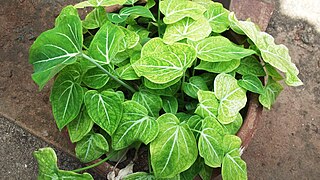
Caladium is a genus of flowering plants in the family Araceae. They are often known by the common name elephant ear, heart of Jesus, and angel wings. There are over 1000 named cultivars of Caladium bicolor from the original South American plant.

Monstera is a genus of 45 species of flowering plants in the arum family, Araceae, native to tropical regions of the Americas. The genus is named from the Latin word for "monstrous" or "abnormal", and refers to the unusual leaves with natural holes that members of the genus have.
Astrocasia is a plant genus of the family Phyllanthaceae first described as a genus in 1905. It is included in the subtribe Astrocasiinae. It is native to Mesoamerica, northern South America, and the western part of the West Indies.
- Astrocasia austinii(Standl.) G.L.Webster - Izabal
- Astrocasia diegoaeJ.Jiménez Ram. & Mart.Gord. - Guerrero
- Astrocasia jacobinensis(Müll.Arg.) G.L.Webster - Bahia, Bolivia
- Astrocasia neurocarpa(Müll.Arg.) I.M.Johnst. ex Standl. - Oaxaca, Querétaro, San Luis Potosí, Tamaulipas
- Astrocasia peltataStandl. - Costa Rica, Nayarit, Jalisco
- Astrocasia tremula (Griseb.) G.L.Webster - Mexico, Central America, West Indies, northern South America
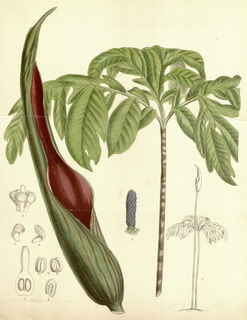
Dracontium is a genus of flowering plants similar to those of Amorphophallus. Unlike Amorphophallus which is found in the Old World, this genus has a New World distribution and is native to South America, Central America, southern Mexico, and the West Indies.

Spathiphyllum montanum is a flowering plant of the genus Spathiphyllum in the family Araceae. It is native to Panama and Costa Rica.

Spathiphyllum silvicola is a flowering plant of the genus Spathiphyllum in the family Araceae. It is native to Colombia and Costa Rica.
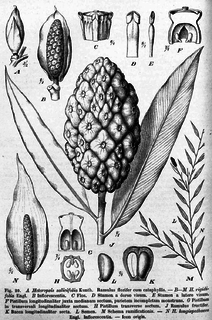
Heteropsis is a genus of plants in the family Araceae, native to Central and South America.
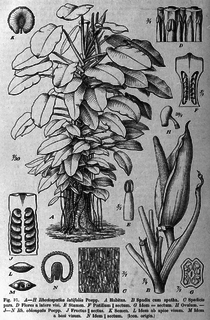
Rhodospatha is a genus of plant in family Araceae. It is native to South America, Central America, and southern Mexico.

Stenospermation is a genus of plant in family Araceae native to South America and Central America.

Epipremnum is a genus of flowering plants in the family Araceae, found in tropical forests from China, the Himalayas, and Southeast Asia to Australia the western Pacific. They are evergreen perennial vines climbing with the aid of aerial roots. They may be confused with other Monstereae such as Rhaphidophora, Scindapsus and Amydrium.
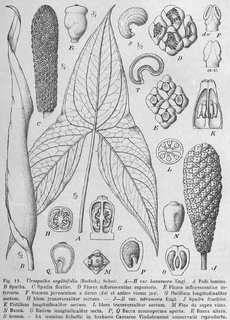
Urospatha is a genus of flowering plants in the family Araceae that consists of approximately 10 known species. They are found growing in South America and Central America in swamps, wet savannahs, and brackish water. The leaves of the species in this genus are upward pointing and sagittate (arrow-shaped). The inflorescences are quite unique; the spathe is mottled and elongated with a spiral twist at the end. The seeds are distributed by water and have a texture similar to cork that allows them to float. They also quickly germinate in water.
Chlorospatha is a genus of flowering plants in the family Araceae. Chlorospatha can be found from Costa Rica, Panama, Colombia, Ecuador, and Peru.

Spathicarpa is a genus of flowering plants in the family Araceae, all of which are endemic to South America. Spathicarpa species are notable for the fact that the entirety of their spadix is fused to the spathe. The genus is believed to be closely related to Spathantheum. The tribe Spathicarpeae is named after the genus Spathicarpa.

Monstera epipremnoides is a species of flowering plant in the family Araceae, endemic to Costa Rica.

Pitcairnia wendlandii is a flowering plant in the Bromeliaceae family. It is native to Costa Rica, Panama, Honduras, Guatemala and Chiapas.

Syngonium podophyllum is a species of aroid, and commonly cultivated as a houseplant. Common names include: arrowhead plant, arrowhead vine, arrowhead philodendron, goosefoot, nephthytis, African evergreen, and American evergreen. The species is native to a wide region of Latin America from Mexico through Bolivia, and naturalized in the West Indies, Florida, Texas, Hawaii, and other places.
Philonotion is a genus of plants in the Araceae. It has three known species, native to tropical South America. Some authorities regard it as part of the related genus Schismatoglottis.
- Philonotion americanum(A.M.E.Jonker & Jonker) S.Y.Wong & P.C.Boyce - Brazil, Colombia, Venezuela, the Guianas
- Philonotion bolivaranum(G.S.Bunting & Steyerm.) S.Y.Wong & P.C.Boyce - Venezuela
- Philonotion spruceanumSchott - Venezuela, Colombia, Peru, Bolivia, northwestern Brazil
Monstera acuminata, or shingle plant, is a species of flowering plant from family Araceae which is widespread from Mexico to Central America. It is abundant in central Petén and extends north to San Luis Potosí, making it the northernmost of the species of Monstera.















